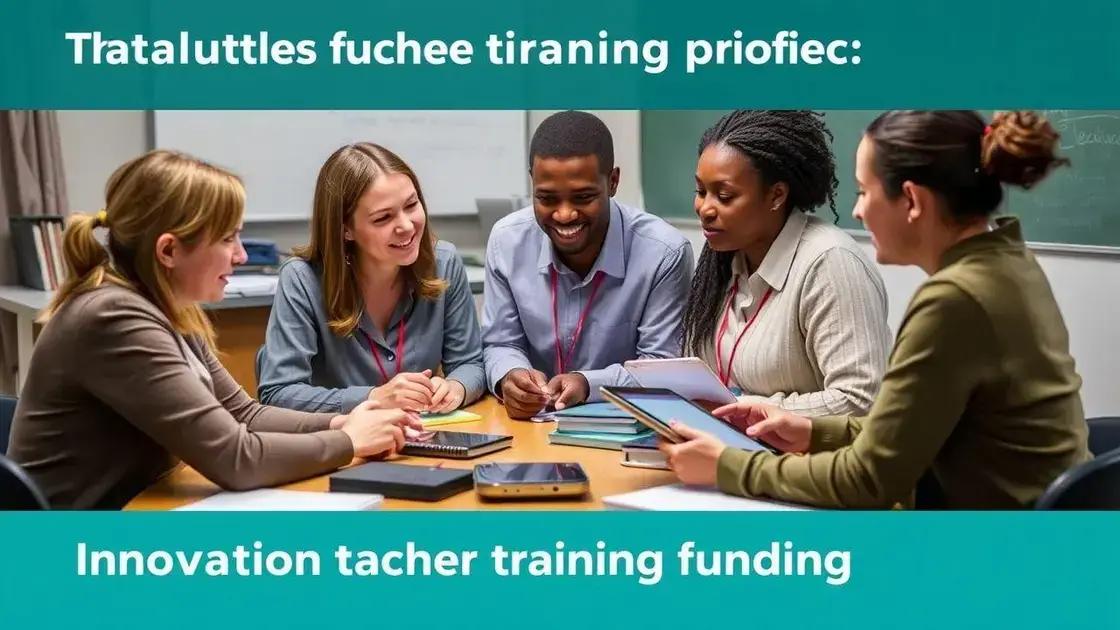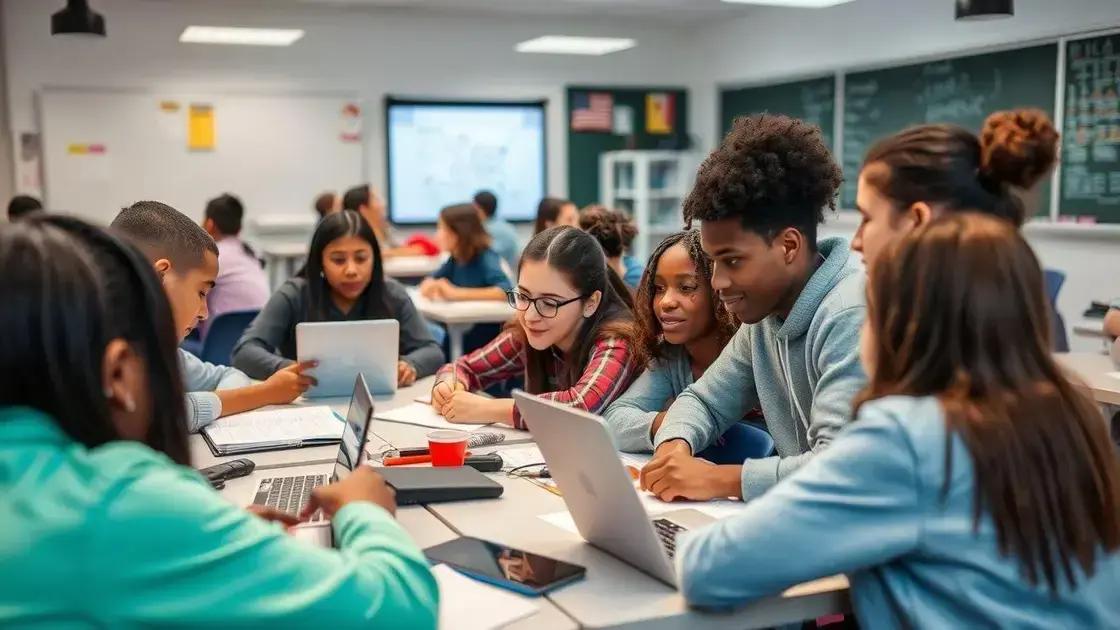Teacher training grants: Unlocking funding for educators

Anúncios
Teacher training grants provide essential funding for educators to enhance their skills, implement innovative teaching methods, and ultimately improve student outcomes in educational settings.
Teacher training grants can transform your professional development journey as an educator. Have you ever wondered how these grants might open doors for new skills and experiences? Let’s dive into the world of educational funding!
Anúncios
Understanding teacher training grants
Understanding teacher training grants is vital for educators looking to enhance their skills and elevate classroom experiences. These grants are financial resources aimed at supporting teachers in their professional development efforts. Knowing how they work can help you make informed decisions about applying for them.
What are teacher training grants?
Teacher training grants are designed to provide funding for various educational programs. They can support workshops, conferences, and advanced degree courses. By utilizing these grants, educators can continuously improve their teaching methods and expand their knowledge.
Anúncios
Why are they important?
These grants not only help teachers grow but also directly benefit students. When educators enhance their skills, they can offer more engaging and effective learning experiences.
- Increases teacher motivation and satisfaction.
- Improves student performance and outcomes.
- Encourages lifelong learning among educators.
Applying for a teacher training grant typically involves identifying available grants and understanding their specific requirements. Each grant may have unique eligibility criteria, deadlines, and funding limits. Therefore, thoroughly researching each opportunity is essential for success. It can feel overwhelming, but breaking it down into manageable steps can help.
How to find grants?
Numerous resources can assist you in finding the right grants. Government agencies, educational associations, and private foundations often provide funding. Websites dedicated to teacher resources can also be helpful.
- Check local education departments.
- Explore online grant databases.
- Network with other educators for recommendations.
Remember, the key to successfully securing a grant lies in understanding what each grant offers and aligning it with your professional goals. Taking the time to learn about teacher training grants can open up numerous opportunities for both your teaching career and your students’ learning experiences.
Types of available grants
There are various types of available grants specifically designed for teacher training. Understanding these categories can help educators choose the most suitable opportunity for their professional growth.
Federal grants
Federal grants are typically funded by government agencies and are available to educators across the country. These grants can cover a wide range of training programs, from workshops to advanced degrees. They often have specific eligibility requirements that applicants must meet.
State grants
Many states offer their own grant programs, which may focus on particular needs within the state’s education system. State grants can be easier to access and often require less paperwork than federal grants. They may also provide funding for localized professional development.
- Focus on state-specific needs.
- May cover costs for local workshops.
- Often have fewer eligibility requirements.
In addition to federal and state grants, private foundations also play a crucial role in funding teacher training. These grants are often provided by organizations dedicated to educational improvement. The specific goals of these grants can vary widely, and they may focus on innovative teaching practices or specific subject areas.
Professional association grants
Professional associations related to education often provide grants to their members. These associations offer resources and support for educators seeking to enhance their expertise. Being a member of such associations can increase your chances of accessing exclusive funding opportunities.
- May target specific subject areas.
- Encourage collaboration among educators.
- Often support innovative teaching methods.
Understanding these types of available grants allows educators to navigate the funding landscape more effectively. Whether through federal, state, or private resources, there are numerous opportunities out there waiting to be explored.
Eligibility criteria for applications
When considering eligibility criteria for applications, it’s essential for educators to carefully review the requirements set forth by each grant. These criteria can significantly vary depending on the funding source.
Common eligibility requirements
Most grants require applicants to meet specific criteria to qualify. Here are some common requirements you may encounter:
- Must be a certified teacher or educator.
- Generally, applicants need to work in a public or accredited private school.
- Some grants may target specific grade levels or subject areas.
- A minimum number of teaching years may be required.
Understanding these basic requirements helps educators determine which grants are worth applying for. Each grant program will have its own unique elements, so it’s crucial to read all guidelines thoroughly.
Special considerations
Some grants may also include special considerations based on location or specific subjects. For example, rural schools may have access to unique grants aimed at improving education in underserved areas. Similarly, grants aimed at STEM education can prioritize educators teaching science, technology, engineering, or math courses.
- Grants may prioritize educators from low-income areas.
- Programs may support educators working with diverse student populations.
- Specific projects or initiatives might also influence eligibility.
Engaging in thorough research about eligibility criteria for applications can empower educators to craft strong applications that match their qualifications with the funding opportunities available. It is important to align your experience and goals with the grant’s focus, which can enhance the chances of securing the funding you seek.
How to write a winning grant proposal

Writing a winning grant proposal can significantly impact your chances of securing funding for teacher training. Understanding how to craft a compelling proposal is essential for success.
Start with thorough research
The first step in writing a successful grant proposal is conducting thorough research. You need to understand the specific requirements from the funding organization. Every grant may have different guidelines and objectives that you must align your proposal with.
Structure your proposal effectively
An effective grant proposal typically follows a clear structure. This generally includes an introduction, a statement of need, project goals, a detailed plan, and a budget outline. Clearly articulating your project and needs makes it easier for the reviewers to understand your intentions.
- Begin with a strong introduction that captures attention.
- Clearly outline the needs your project addresses.
- Explain your project goals and the impact on education.
- Detail your implementation plan with timelines and responsibilities.
In each section of your proposal, you should emphasize how your project aligns with the grant’s objectives. Use concrete data and examples to support your claims, which shows the reviewers the importance of your work. This not only strengthens your case but also demonstrates your commitment to improving educational outcomes through teacher training.
Provide a detailed budget
A detailed budget is a critical component of a winning grant proposal. Ensure that you justify each expense and show how it contributes to the overall success of your project. Providing a realistic budget reassures funders that you have thought the project through and are capable of managing the funds responsibly.
- Break down costs into categories (e.g., materials, travel, training).
- Include any matching funds or additional funding sources.
- Keep the budget clear and easy to understand.
Finally, always proofread and revise your proposal before submission. Typos or unclear language can detract from your message. Having colleagues review your work can also provide valuable feedback and help you refine your proposal. By following these guidelines, you will be well on your way to crafting a winning grant proposal that stands out.
Key deadlines and application processes
Understanding the key deadlines and application processes for grants is crucial for teachers seeking funding. Missing a deadline can mean losing the opportunity for valuable resources that could enhance your teaching skills.
Types of deadlines
Deadlines can vary significantly by grant. Most grants have several important dates you need to watch for. Some of these include:
- Application submission deadline.
- Notification of award date.
- The start and end dates for the grant period.
Each grant will specify its unique timeline. Make sure to mark these dates in your calendar to ensure you stay on track. Being aware of these key deadlines helps reduce stress as you prepare your application.
Application process overview
The application process can seem overwhelming at first, but breaking it down into manageable steps can help. Start by gathering necessary materials, such as your teaching credentials and project information. Many grants require specific documentation to verify eligibility and showcase your plans.
Next, ensure that you follow the application instructions carefully. Each grant will have particular requirements and formats for submission. Pay attention to details, as even small errors can lead to disqualification. In case of online submissions, check for submission confirmation to ensure your application was received.
Tips for managing deadlines
To effectively manage deadlines, consider creating a timeline for your grant application process. Include all key dates, as well as internal deadlines for completing drafts and assembling necessary materials. Regularly reviewing this timeline will keep you focused and organized.
- Set reminders for each key date on your calendar.
- Share your timelines with colleagues for accountability.
- Allocate specific times for writing and editing your proposal.
By planning ahead and managing your time wisely, you can easily navigate the key deadlines and application processes for teacher training grants, ultimately increasing your chances of receiving funding.
Tips for maximizing your grant potential
To maximize your grant potential, it’s essential to approach the application process strategically. A well-prepared proposal can significantly enhance your chances of receiving funding.
Research thoroughly
The first tip is to conduct thorough research. Understanding the priorities and goals of the funding organization helps you tailor your proposal to align with their objectives. Review past successful applications if possible. This can provide insights into what funders are looking for.
Connect with funders
Establishing a connection with funders can also be beneficial. Attend grant workshops, webinars, or informational sessions. These events offer opportunities to ask questions and gain clarity on the application process. Networking with other applicants can also provide valuable advice.
- Join online forums related to education funding.
- Follow grant opportunities on social media.
- Contact program officers with any questions.
When writing your proposal, focus on clear and concise language. Avoid jargon that could confuse reviewers. Instead, make your points straightforward and compelling. This clarity helps convey your vision effectively.
Demonstrate impact
Another critical aspect is demonstrating the potential impact of your project. Clearly outline how the funding will help improve educational outcomes. Use data and evidence to support your claims. Share stories or testimonials from your school community that illustrate the need for your project.
- Include concrete data and statistics.
- Show how your project aligns with educational trends.
- Highlight the benefits for students and teachers.
Finally, always follow the application guidelines closely. Each funder has specific requirements, and adhering to them shows your attentiveness and professionalism. Make a checklist of all submission requirements to ensure nothing is overlooked. By focusing on these tips for maximizing your grant potential, you can create a stronger application and increase your chances of securing the funding you need.
Success stories from funded educators
Success stories from funded educators showcase how teacher training grants can transform teaching practices and improve student outcomes. These real-life examples highlight the benefits of securing funding and the positive impact on educational environments.
Innovative teaching methods
Many educators have used grant funding to implement innovative teaching methods in their classrooms. For instance, one math teacher received a grant to introduce a hands-on learning program. This initiative helped students grasp complex concepts through interactive activities. As a result, their test scores improved significantly.
Professional development
Another compelling story comes from a science teacher who utilized grant money to attend a national conference on new science curriculum standards. After attending the conference, she integrated new teaching strategies that engaged her students better. The feedback from her students and their parents indicated a noticeable increase in enthusiasm for science.
- Funding provided access to specialized training.
- Professional development led to new curriculum innovations.
- Enhanced student engagement and learning outcomes.
Additionally, a group of teachers collaborated on a grant that funded a literacy program aimed at struggling readers. By creating a supportive reading environment with specialized resources, they saw dramatic improvements in their students’ reading skills. Teachers reported not only better reading levels but also increased confidence in their students.
Community involvement
Many funded projects also foster community involvement. For example, one school used grant funds to establish a mentorship program that connected students with local professionals. This initiative not only enriched the students’ learning experiences but also strengthened community ties.
- Mentorship programs enhance student connections.
- Community engagement fosters a supportive learning environment.
- Students learn real-world skills from local professionals.
The success stories from funded educators illustrate the transformative power of teacher training grants. These grants enable educators to innovate, improve their teaching methods, and ultimately enhance the educational experience for their students.
The future of teacher training funding

The future of teacher training funding is evolving rapidly, reflecting changes in educational needs and funding sources. As the demand for skilled educators continues to rise, so does the need for innovative funding solutions.
Increased investment in education
Recent trends indicate that governments and private organizations are recognizing the importance of investing in teacher training. There is an increasing emphasis on preparing educators for modern classrooms, which now often include technology integration and diverse student populations. This investment can lead to improved educational outcomes for students.
Partnerships with technology companies
Another significant trend involves partnerships between educational institutions and technology companies. These partnerships can provide targeted funding and resources aimed at equipping teachers with the skills needed for a digital-centered environment. By collaborating with tech firms, schools can access training programs that focus on integrating technology into lesson plans.
- Access to innovative tools and resources.
- Training on technical skills relevant to the classroom.
- Support for ongoing professional development.
Additionally, many districts are exploring alternative funding through grants and community resources. This shift allows educators to pursue specialized training that aligns with their students’ needs. As these funding sources multiply, the potential for enhanced educational programs grows.
Focus on equity in funding
The conversation around equity in education funding is also becoming more prominent. There is a clear recognition that all educators should have access to high-quality training, regardless of their school’s location or socio-economic status. Efforts are being made to target funding towards under-resourced schools and educators, ensuring that every teacher can improve their practice and benefit from professional development.
- Targeted support for teachers in underserved areas.
- Programs designed to address specific challenges faced by diverse learners.
- Encouragement of community involvement and support.
As we look to the future, it is clear that the landscape of teacher training funding will continue to transform. By prioritizing innovative partnerships, equitable access, and strong investments in education, we can ensure that all teachers receive the support they need to succeed in their roles.
FAQ – Frequently Asked Questions about Teacher Training Grants
What are teacher training grants?
Teacher training grants are financial resources that support educators in their professional development, allowing them to enhance their teaching skills.
Who can apply for these grants?
Typically, certified teachers or educators working in accredited schools are eligible to apply for teacher training grants.
How can I find available grants for teacher training?
You can find available grants through government websites, educational organizations, and private foundations that focus on improving education.
What are the benefits of receiving a teacher training grant?
Receiving a teacher training grant can provide you with access to innovative teaching methods, professional development opportunities, and resources aimed at improving student outcomes.






